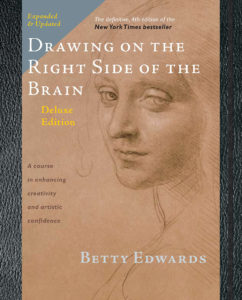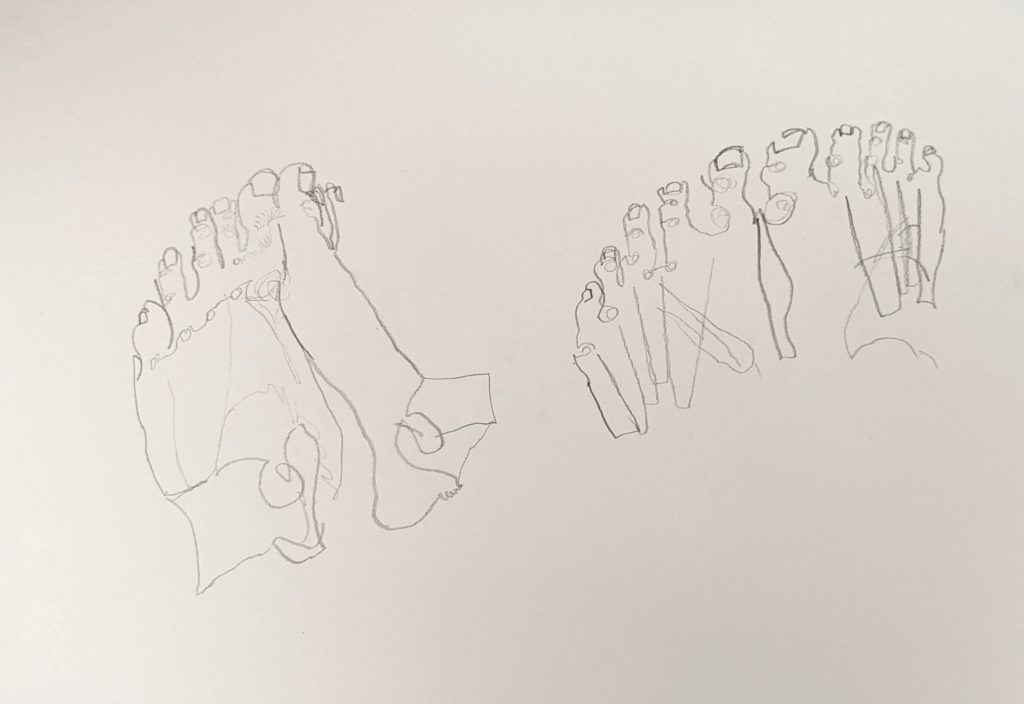What mindfulness, drawing, and poetry have in common
I meditate and while I wish I could say I do so as a daily practice, I’ve been mediating long enough to understand how to bring my body and mind into sync. I don’t always get there, but when I do, it’s truly liberating and often insightful. One of the mantras I say to myself is, “I follow my breath all the way in” (on the inhale) and, on the way out, “I follow my breath all the way out.” This keeps my mind from rushing ahead of my body, slowing me down to focus on the actual stream of my breath, not merely the act of breathing.
 While meditating the other day, I realized that this close focus and awareness is very similar cognitively to the process of drawing from the right side of the brain, which is described in Betty Edwards very popular book, Drawing on the Right Side of the Brain, first published in 1979 and newly revised. Translated into seventeen languages, this book is, according to Amazon’s description, “the world’s most widely used instructional drawing book.” Taylor’s teachings involve contour drawing, which means drawing the outline of an object, which could be a pine cone, a flower, a kitchen strainer (any interestingly shaped object) and, here’s the key feature, not looking at what you are drawing. Well, it really works! And the way it works because you are focusing on each minute wiggle and curve of your hand, you aren’t thinking about what it is you are supposed to be drawing (the symbol making that comes from the left side of the brain); you slow down your hand and your brain and shift to the more intuitive and creative right side. Like mindfulness, this act of paying careful attention—in one case, to the stream of your breath, and in the other, to the stream of your hand—is what I’ve found enables me to be attuned to the present moment and to a much more meaningful and successful experience meditating and drawing.
While meditating the other day, I realized that this close focus and awareness is very similar cognitively to the process of drawing from the right side of the brain, which is described in Betty Edwards very popular book, Drawing on the Right Side of the Brain, first published in 1979 and newly revised. Translated into seventeen languages, this book is, according to Amazon’s description, “the world’s most widely used instructional drawing book.” Taylor’s teachings involve contour drawing, which means drawing the outline of an object, which could be a pine cone, a flower, a kitchen strainer (any interestingly shaped object) and, here’s the key feature, not looking at what you are drawing. Well, it really works! And the way it works because you are focusing on each minute wiggle and curve of your hand, you aren’t thinking about what it is you are supposed to be drawing (the symbol making that comes from the left side of the brain); you slow down your hand and your brain and shift to the more intuitive and creative right side. Like mindfulness, this act of paying careful attention—in one case, to the stream of your breath, and in the other, to the stream of your hand—is what I’ve found enables me to be attuned to the present moment and to a much more meaningful and successful experience meditating and drawing.
So what does this have to do with poetry? I practice free writes on a regular basis, sometimes in a poetry group, sometimes by myself. In our free-write group, we begin with a line from a poem and turn on a timer for 4 minutes, 19 seconds, a practice we learned from our mentor, Barbara Helgott Hyett. During a free write, there’s no time for the brain to think about intention; the stream of unconscious writing is triggered by the prompt. For example, a recent prompt was a line from Walt Whitman, “The moon gives you light,” which led me to a memory of standing on a balcony with my boyfriend on the day of his birthday and the day before mine. I don’t think I’ll have a finished poem from this prompt, but I do generate many of my poems from free writes. Like meditating, like contour drawing, free writes pull me into the present moment. Frank Stafford likened poetry to fishing. “You throw your line into the water and wait for a little tug.” And when I am drafting a poem, describing an image, for example, I’m focused not only on what I’m saying but what I’m hearing, allowing the sound of a word to unconsciously take me to the next word by means of alliteration, slant rhyme, assonance, or consonance. For example, here’s the opening line from a recent poem, “On Discovering a Wolf Spider Carrying Her Spiderings on Her Back”:
A quick jitter on the ground, the bulbous back pebbled with bumps,
I can’t say for sure, but I think “jitter” came to me first by remembering the way the spider moved, and then my mind leaped to “quick” because of the sound. And I can’t say if “bulbous” or “back” came first, but I think both arrived sonically before “bumps.” But my real point is that when I’m engaged fully in listening to each word as it arises, I become present in much the same way I do at the level of each breath when I’m at my mediating-best, or when I’m following my hand when contour drawing: attuned, not to the sentence level and surely not to where I think I want to or should go, but exactly at the level of the word, and the rhythms, syntax, and sounds that spring from that word—in other words, attuned exactly to where I am.

Wendy Drexler’s blog post “What Mindfulness, Drawing, and Poetry Have in Common” explores the similarities among these three activities. She draws parallels between the focused attention required in mindfulness, the detailed observation in drawing, and the creative expression in poetry. Drexler shares how these practices help her stay present in the moment, enhancing her experiences in meditation, artistic creation, and writing.
If you’re looking for Lahore Escorts Services you’ve come to the right place. You can get an idea of the Top Young Ladies and their Attendants in Lahore through this composition. These are the young females who will make sure you have a great time in Lahore.
Hello friends I am Kolkata Dream Shots Night for Full Escorts in Kolkata available for escort service.